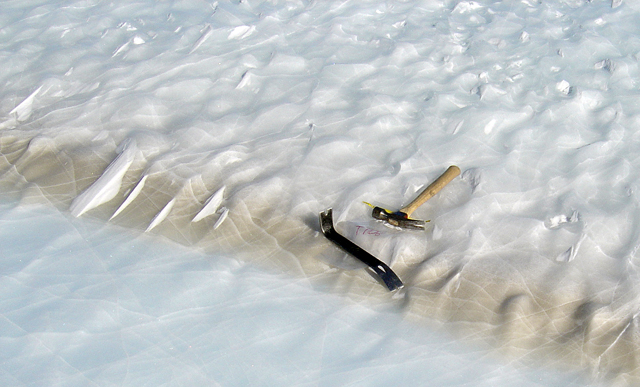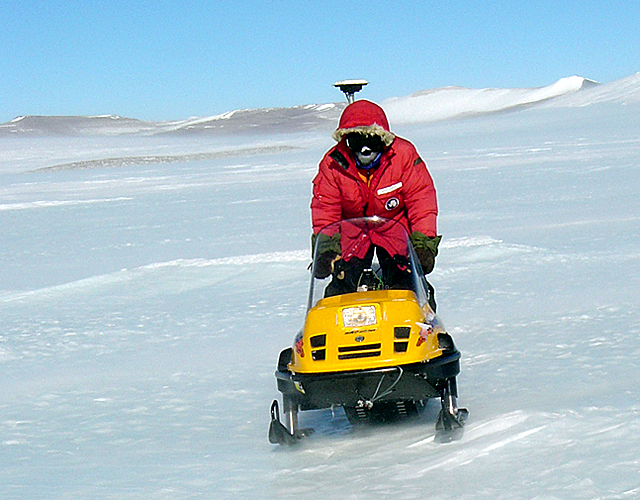
THE OLDEST ICE CORE retrieved from Antarctica—and the world—travels back about 850,000 years in time, revealing eight previous ice ages. It took the European Project for Ice Coring in Antarctica (EPICA) more than five field seasons to drill down 3,270 meters into the East Antarctic ice sheet.
Andrei Kurbatov and his colleagues believe that they can retrieve a nearly limitless supply of ice for climate research that dates back at least 2.5 million years"located right at the surface and retrievable in a single season.
The proverbial gold mine of old ice is located in a region called the Allan Hills Blue Ice Area, only about an hour's plane ride away from McMurdo Station , the hub of the U.S. Antarctic Program.
Snow covers most of Antarctica, but in blue ice areas, wind scours the snow from the surface. Sublimation—a process that turns snow immediately into water vapor in the air—takes care of the rest. Blue ice areas generally form where subglacial mountains obstruct ice flow, pushing the ice below to the surface. The surface ice closest to Allan Hills is the oldest ice and ages Benjamin Button-style farther away one moves horizontally.

"It's right on the surface, and if we sample it right, we should be able to complement existing ice core records," said Kurbatov, an assistant research professor at University of Maine's Climate Change Institute.
The first indication that Allan Hills held million-year-old ice actually came from meteorites collected there by scientists working on the Antarctica Search for Meteorites program for more than three decades, according to Kurbatov. Dating of the extraterrestrial rocks at the surface suggested an age of at least a million years. In addition, meteorite fragments buried in the ice just below the surface date back about 2.5 million years.
Kurbatov said previous work by William McIntosh and Nelia Dunbar, with the New Mexico Bureau of Geology and Mineral Resources at New Mexico Tech, revealed an ash layer in the blue ice that turned out to be four million years old, further bolstering the idea that old ice was available for the picking without multi-million-dollar ice drilling operations.
"The whole purpose of this project is to confirm that the ice is good for the reconstruction of climate," Kurbatov explained. "Once we've done that, technically we could map this ice."

Kurbatov and his team will have two field seasons to collect samples from shallow ice cores and horizontal trenches using a machine developed and used by McIntosh and Dunbar about 10 years ago. The ice cutter—a four-wheeled, steel-framed contraption that sports two chainsaws at 45-degree angles—cuts a horizontal trench into the ice, pushed from behind like a lawnmower.
The scientists will date the core mainly using a novel technique comparing the stable isotope ratio of Argon-38 and Argon-40 gas bubbles trapped in the ice, developed by colleague Michael Bender at Princeton University . The gas measurements allow the scientists to date the ice based on decay of the argon.
"It will probably be one of the best dates available to us," Kurbatov said.
If the ice proves viable—samples contain the same sort of properties as ice cores such as trapped gas and dust particles that provide information about past climate—Kurbatov said the Allan Hills could prove to be a "climate park" where investigators can request ice of varying ages for an experiment.
"The problem with ice core records, it's never enough ice [for research]," he said, though stressed that ice cores remain the "gold standard" for climate research. "Ice cores are a crucial part of the Antarctica science program."
But the blue ice at Allan Hills does offer a sort of proxy time machine for climate far beyond what's available today from ice cores. Based on climate records from ocean sediment cores, which can contain tens of millions of years of history, scientists know that ice ages used to wax and wane on a roughly 40,000-year cycle. About a million years ago, that became a 100,000-year cycle.
No one really knows why. And sediment cores don't really offer the sort of resolution—the finer details—that researchers need to tease out an answer. That keystone could be right underfoot in the blue ice at Allan Hills.
"You have everything that was in the atmosphere. You preserve it like an archive," Kurbatov said. "That's why we really want to get this old ice, and see if it can show us something interesting."
